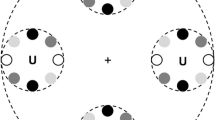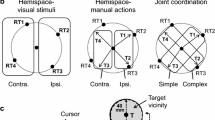Abstract
Normally, simple digital or manual responses to a light stimulus in the right or left visual hemifields are performed faster with uncrossed hand-field combinations than with crossed hand-field combinations. Because of the organization of visual and motor pathways, the integration of uncrossed responses is assumed to occur within a single hemisphere, whereas a time-consuming inter-hemispheric transfer via the corpus callosum is considered to be necessary for the integration of crossed responses. However, callosal transfer may be dispensable for those crossed responses which can be controlled through ipsilaterally descending motor pathways by the hemisphere receiving the visual stimulus. We investigated crossed-uncrossed differences (CUDs) in speed of simple visuomotor responses to lateralized flashes in one subject with total section of the corpus callosum and two subjects with complete callosal agenesis. We recorded the reaction times as well as the premotor times, as indicated by the electromyographic latencies of the prime movers, of three types of responses: a distal response involving a thumb flexion, a proximal response chiefly involving a forearm flexion and an axial response involving a shoulder elevation. Further, the three types of responses to a single lateralised flash were performed both unilaterally and bilaterally. The three acallosal subjects showed CUDs greatly exceeding normal values on distal responses, either unilateral or bilateral, and on unilateral proximal responses. These abnormally long CUDs stood in sharp contrast to the insignificant CUDs exhibited by the same subjects on bilateral proximal responses and on unilateral and bilateral axial responses in agreement with correspondingly insignificant CUDs reported for normal subjects. These results confirm that a callosal contribution is important for the execution of fast distal and unilateral proximal responses to a visual stimulus directed to the hemisphere ipsilateral to the responding hand. By contrast, the other types of crossed responses appear to be efficiently coordinated across the midline without the aid of the corpus callosum. This is in keeping with the hypothesis that they are governed by a bilaterally distributed motor system which is preferentially activated for the execution of symmetrical bilateral movements, employing axial and proximal limb muscles.
Similar content being viewed by others
References
Aglioti S, Dall'Agnola R, Girelli M, Marzi CA (1991) Bilateral hemispheric control of foot distal movements: evidence from normal subjects. Cortex 27:571–581
Anzola GP, Bertoloni G, Buchtel HA, Rizzolatti G (1977) Spatial compatibility and anatomical factors in simple and choice reaction time. Neuropsychologia 15:295–305
Bashore TR (1981) Vocal and manual reaction time estimates of interhemispheric transmission time. Psychol Bull 89:352–368
Benecke R, Meyer B-U, Freund H-J (1991) Reorganisation of descending motor pathways in patients after hemispherectomy and severe hemispheric lesions demonstrated by magnetic brain stimulation. Exp Brain Res 83:419–426
Berlucchi G, Heron W, Hyman R, Rizzolatti G, Umiltà C (1971) Simple reaction time of ipsilateral and contralateral hand to lateralized visual stimuli. Brain 94:419–430
Berlucchi G, Crea F, Di Stefano M, Tassinari G (1977) Influence of spatial stimulus-response compatibility on reaction time of ipsilateral and contralateral hand to lateralized light stimuli. J Exp Psychol, Hum Percept Perform 3:505–517
Bogen JE (1987) Physiological consequences of complete or partial commissural section. In Apuzzo MLJ (ed) Surgery of the third ventricle. Williams & Wilkins, Baltimore, pp 175–194
Botwinick J, Thompson LW (1966) Premotor and motor components of reaction time. J Exp Psychol 71:9–15
Briggs GG, Nebes RD (1975) Patterns of hand preference in a student population. Cortex 11:230–238
Brinkman J, Kuypers HGJM (1973) Cerebral control of contralateral and ipsilateral arm, hand and finger movements in the split-brain rhesus monkey. Brain 96:653–674
Chelazzi L, Marzi CA, Panozzo G, Pasqualini N, Tassinari G, Tomazzoli L (1988) Hemiretinal differences in speed of light detection in esotropic amblyopes. Vision Res 28:95–104
Clarke JM, Zaidel E (1989) Simple reaction times to lateralized light flashes: varieties of interhemispheric communication routes. Brain 112:871–894
Colebatch JG, Gandevia SC (1989) The distribution of muscular weakness in upper motor neuron lesions affecting the arm. Brain 112:749–763
Colebatch JG, Rothwell JC, Day BL, Thompson PD, Marsden CD (1990) Cortical outflow to proximal arm muscles in man. Brain 113:1843–1856
Colebatch JG, Deiber M-P, Passingham RE, Friston KJ, Frackowiak RSJ (1991) Regional cerebral blood flow during voluntary arm and hand movements in human subjects. J Neurophysiol 65:1392–1401
Di Stefano M, Morelli M, Marzi CA, Berlucchi G (1980) Hemispheric control of unilateral and bilateral movements of proximal and distal parts of the arms as inferred from simple reaction time to lateralized light stimuli in man. Exp Brain Res 38:197–204
Di Stefano M, Sauerwein HC, Lassonde M (1992) Influence of anatomical factors and spatial compatibility on the stimulus-response relationship in the absence of the corpus callosum. Neuropsychologia 30:177–185
Fiorentini A, Berardi N, Falsini B, Porciatti V (1992) Interhemispheric transfer of visual perceptual learning in callosal agenesis. Clin Vis Sci 7:133–141
Freund H-J (1987) Abnormalities of motor behaviour after cortical lesions in humans. In: Handbook of physiology, vol. V, part 2, American Physiological Society, Bethesda, pp 763–810
Gazzaniga MS: The bisected brain. Appleton-Century-Crofts, New York, 1970
Gazzaniga MS, Smylie CS (1990) Hemispheric mechanisms controlling voluntary and spontaneous facial expressions. J Cogn Neurosci 2:239–245
Gazzaniga MS, Bogen JE, Sperry RW (1967) Dyspraxia following division of the cerebral commissures. Arch Neurol 16:606–612
Glickstein M (1990) Brain pathways in the visual guidance of movement and the behavioural function of the cerebellum. In: Trevarthen CB (ed) Brain circuits and functions of the mind. Cambridge University Press, Cambridge, pp 157–167
Holtzman JD (1984) Interactions between cortical and subcortical visual areas: evidence from human commissurotomy patients. Vis Res 8:801–813
Jeannerod M (1988) The neural and behavioural organization of goal-directed movements. Oxford University Press, Oxford
Jeeves MA (1969) A comparison of interhemispheric transmission times in acallosals and normals. Psychon Sci 16:245–246
Jeeves MA (1990) Agenesis of the corpus callosum. In Boller F, Graman J (eds) Handbook of neuropsychology, vol 4, Elsevier, Amsterdam, pp 99–114
Jeeves MA, Silver PH, Jacobson I (1988) Bimanual co-ordination in callosal agenesis and partial commissurotomy. Neuropsychologia 26:833–850
Jung R, Dietz V (1975) Verzögerter Start der Willkürbewegung bei Pyramidenläsionen des Menschen. Arch Psychiat Nervenkr 221:87–109
Keating EG (1973) Loss of visual control of the forelimb after interruption of cortical pathways. Exp Neurol 41:635–648
Kuypers HGJM (1987) Some aspects of the organization of the output of the motor cortex. In Ciba Foundation Symposium 132: Motor areas of the cerebral cortex. Wiley, Chichester, pp 63–82
Kuypers HGJM (1989) Motor system organization. In Adelman G (ed) Encyclopedia of neuroscience, suppl 1. Birkhäuser, Boston, pp 107–110
Ledlow A, Swanson JM, Kinsbourne M (1978) Differences in reaction times and average evoked potentials as a function of direct and indirect neural patways. Ann Neurol 3:525–530
Levy J, Wagner N (1984) Handwriting posture, visuomotor integration, and lateralized reaction-time parameters. Hum Neurobiol 3:157–161
Lund JS, Downer L de C, Lumsley JSP (1970) Visual control of limb movement following section of optic chiasm and corpus callosum in the monkey. Cortex 6:323–346
Marzi CA, Bisiacchi P, Nicoletti R (1991) Is interhemispheric transfer of visuomotor information asymmetric? Evidence from a meta-analysis. Neuropsychologia 29:1163–1177
Milner AD (1982) Simple reaction times to lateralized visual stimuli in a case of callosal agenesis. Neuropsychologia 20:411–419
Milner AD, Jeeves MA, Silver PH, Lines CR, Wilson JG (1985) Reaction times to lateralized visual stimuli in callosal agenesis: stimulus and response factors. Neuropsychologia 23:323–331
Milner AD, Miln AB, Mackenzie AM (1989) Simple reaction times to lateralized visual stimuli using finger-thumb apposition. Med Sci Res 17:859–860
Müller F, Kunesch E, Binkofski F, Freund H-J (1991) Residual sensorimotor functions in a patient after right-sided hemispherectomy. Neuropsychologia 29:125–145
Myers JL (1979) Fundamentals of experimental design. Allyn and Bacon, Boston
Myers JJ, Sperry RW (1985) Interhemispheric communication after section of the forebrain commissures. Cortex 21:249–260
Palmer E, Ashby P (1992) Corticospinal projections to upper limb motoneurones in humans. J Physiol (Lond) 448:397–412
Poffenberger AT (1912) Reaction time to retinal stimulation with special reference to the time lost in conduction through nervous centers. Arch Psychol 23:1–73
Posner MI, Cohen Y, Rafal RD (1982) Neural systems control of spatial orienting. Phil Trans R Soc Lond B 298:187–198
Preilowski B (1972) Possible contribution of the anterior forebrain commissures to bilateral coordination. Neuropsychologia 10:266–277
Reynolds DMcQ, Jeeves MA (1974) Further studies of crossed and uncrossed pathway responding in callosal agenesis: reply to Kinsbourne and Fisher. Neuropsychologia 12:287–290
Saron CD, Davidson RJ (1989) Visual evoked potential measures of interhemispheric transfer time in humans. Behav Neurosci 103:1115–1138
Sergent J (1986) Subcortical coordination of hemisphere activity in commissurotomized patients. Brain 109:357–369
Sergent J (1987) A new look at the human split brain. Brain 110:1375–1392
Sergent J, Myers JJ (1985) Manual, blowing, and verbal simple reactions to lateralized flashes of light in commissurotomized patients. Percept Psychophysics 37:571–578
Smith KU (1947) Bilateral integrative action of the cerebral cortex in man in verbal association and sensorimotor coordination. J Exp Psychol 37:367–376
Sperry RW (1984) Consciousness, personal identity and the divided brain. Neuropsychologia 22:661–673
Sperry RW, Gazzaniga MS, Bogen JE (1969) Interhemispheric relationships: the neocortical commissures; syndromes of hemispheric disconnection. In: Vinken PJ, Bruyn GW (eds) Handbook of clinical neurology, vol 4. North-Holland, Amsterdam, pp 273–290
St. John R, Shields C, Timney B (1987) The reliability of estimates of interhemispheric reaction times derived from unimanual and verbal response latencies. Hum Neurobiol 6:195–202
Swanson J, Ledlow A, Kinsbourne M (1978) Lateral asymmetries revealed by simple reaction time. In: Kinsbourne M (ed) Asymmetrical function of the brain. Cambridge University Press, Cambridge, pp 274–291
Tassinari G, Morelli M, Berlucchi G (1983) Interhemispheric transmission of information in manual and verbal reaction-time tasks. Hum Neurobiol 2:77–85
Tassinari G, Aglioti S, Berlucchi G, Pallini R, Rossi G (1990) Inter-hemispheric communication in patients with partial and total callosotomy. Neurosci Lett [Suppl 39]: 210
Tomberg C, Levarlet-Joye H, Desmedt JE (1991) Reaction times recording methods: reliability and EMG analysis of patterns of motor commands. Electroencephalogr Clin Neurophysiol 81:269–278
Trevarthen C, Sperry RW (1973) Perceptual unity of the ambient visual field in human commissurotomy patients. Brain 96:547–570
Trope I, Fishman B, Gur RC, Sussman NM, Gur RE (1987) Contralateral and ipsilateral control of fingers following callosotomy. Neuropsychologia 25:287–291
Tuller B, Kelso JAS (1989) Environmentally-specified patterns of movement co-ordination in normal and split-brain subjects. Exp Brain Res 75:306–316
Umilta' CA, Nicoletti R (1990) Spatial stimulus-response compatibility. In: Proctor RW, Reeve TG (eds) Stimulus-response compatibility. Elsevier, Amsterdam, pp 89–116
Vallar G, Sterzi R, Basso A (1988) Left hemisphere contribution to motor programming of aphasic speech: A reaction time experiment in aphasic patients. Neuropsychologia 26:511–519
Volpe BT, Sidtis JJ, Holtzman JD, Wilson DH, Gazzaniga MS (1982) Cortical mechanisms involved in praxis: observations following partial and complete section of the corpus callosum in man. Neurology 32:646–650
Author information
Authors and Affiliations
Rights and permissions
About this article
Cite this article
Aglioti, S., Berlucchi, G., Pallini, R. et al. Hemispheric control of unilateral and bilateral responses to lateralized light stimuli after callosotomy and in callosal agenesis. Exp Brain Res 95, 151–165 (1993). https://doi.org/10.1007/BF00229664
Received:
Accepted:
Issue Date:
DOI: https://doi.org/10.1007/BF00229664




